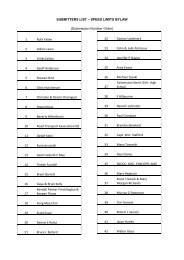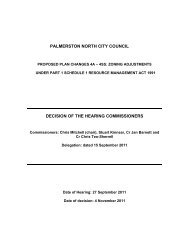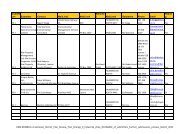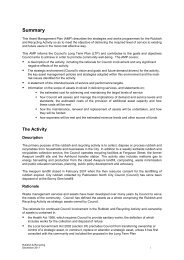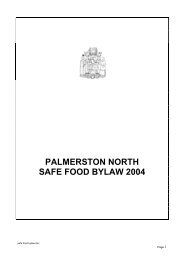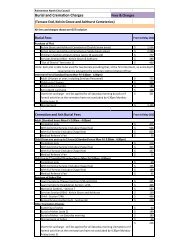P - Transmission
P - Transmission
P - Transmission
- No tags were found...
Create successful ePaper yourself
Turn your PDF publications into a flip-book with our unique Google optimized e-Paper software.
Mighty River Power Ltd27 July 2011Document No. 60214865-001Puketoi Wind FarmTechnical Report<strong>Transmission</strong> Line, Sub Station and Collection System
AECOMPuketoi Wind Farm Technical ReportPuketoi Wind Farm Technical Report<strong>Transmission</strong> Line, Sub Station and Collection SystemPrepared forMighty River Power LtdPrepared byAECOM New Zealand LimitedUnit H, 1 Brynley Street, Hornby, Christchurch 8042, P O Box 710, Christchurch MC, Christchurch 8140, New ZealandT +64 3 363 8500 F +64 3 363 8501 www.aecom.com27 July 201160214865AECOM in Australia and New Zealand is certified to the latest version of ISO9001 and ISO14001.This report has been prepared by AECOM New Zealand Limited on the specific instructions of Mighty River Power Limited as our Client. It is forour Client’s use for the purpose for which it was intended, being the resource consent application for the Puketoi Wind Farm, in accordance withthe agreed scope of work and information provided. Any use or reliance by any person contrary to the above, to which AECOM New ZealandLimited has not given its prior written consent, is at that person’s own risk.27 July 2011
AECOMPuketoi Wind Farm Technical ReportQuality InformationDocumentPuketoi Wind Farm Technical ReportRef 60214865Date 27 July 2011Prepared byReviewed byI Bilbrough, K James, G Urban, K Maddumarachchi, S Kendrick, B Flavall, HPorterRodney UrbanRevision HistoryRevision Revision Date DetailsName/PositionAuthorisedSignatureA 27-Jul-2011 Consent Issue J SchwadererManager T&D27 July 2011
AECOMPuketoi Wind Farm Technical ReportTable of ContentsExecutive Summaryiii1.0 Introduction 11.1 Scope of Investigation 22.0 Overhead Lines 22.1 Line Route Selection 22.1.1 Line Design Methodology 32.2 Line Modelling 32.2.1 Survey Data 32.2.2 Conductor Modelling 32.3 Line Loading 32.3.1 Maximum Wind 32.3.2 Snow & Ice 42.3.3 Conductor Temperatures 42.4 Clearances 42.4.1 Crossings 42.5 Conductor Selection 52.5.1 220kV OHL 52.5.2 33kV OHL 52.5.3 Conductor Tensions 62.6 Insulators and Hardware 62.7 Structure Selection 62.7.1 220kV OHL Structures 62.7.2 33kV OHL Structures 62.8 Structural Analysis 72.9 Foundations 73.0 Collection System 73.1 General 73.2 Unit Sub Station 73.2.1 Step Up Transformer 83.2.2 33 kV RMU 83.2.3 Low Voltage Cabling 83.3 33kV Collection Circuits 83.3.1 Cable Trenches 83.3.2 33 kV Cables 84.0 220/33 kV Substation 94.6 Oil Drainage and Interception System 124.6.1 Description 124.6.2 Oil Volume and Stormwater Criteria 124.6.3 Operation 124.6.4 Transformer Bund Area & Wall Height 124.6.5 Discharge 135.0 Earthing System 135.1 Overview 135.2 Summary 135.3 Soil Resistivity Test and Modelling 145.4 Earth Fault Levels & Clearance Times 145.5 Structure Earth Grid Resistances 145.6 Substation Earth Grid Resistance 145.7 Calculations 146.0 Electromagnetic Field Strength (EMF) 157.0 Preliminary Constructability Review 167.1 Planning and Materials 167.2 Vegetation Management 167.3 Access 167.4 Construction 1727 July 2011
AECOMPuketoi Wind Farm Technical Report7.4.1 Road or Rail Protection 177.4.2 Reinstatement 177.4.3 Line Maintenance 178.0 Conclusion & Recommendations 18List of Figures and TablesList of FiguresFigure 1 Proposed Wind Farm Site 1Figure 2 Unit Sub Station Schematic 8Figure 3 Electric field strength of the 220kV transmission line 15Figure 4 Magnetic flux density of the 220kV and 33kV lines. 16List of TablesTable 1 Line Characteristics 3Table 2 Conductor Temperatures 4Table 3 OHL Conductor Clearances 4Table 4 33kV OHL Existing Crossing Details 5Table 5 220kV OHL Existing crossing Details 5Table 6 Typical Soil Resistivity Profile derived for Puketoi area 14Table 7 Worst case future bus earth fault levels 1427 July 2011
AECOMPuketoi Wind Farm Technical ReportExecutive SummaryMighty River Power Ltd is currently proposing to build a new wind farm in the Puketoi Ranges approximately40kms south east from Palmerston North. The proposed wind farm is to contain up to 53 turbines, each with up to6.15 MW generating capacity. Electricity generated will be collected by combinations of 33kV overhead lines andunderground cables and then fed into the national grid via a 220kV overhead transmission line.AECOM has been engaged by MRP to provide details of the transmission system to be used to connect thePuketoi Wind Farm to the Turitea Wind Farm and the national grid.<strong>Transmission</strong> line and internal reticulation design has taken into consideration line capacity, transmission voltage,clearance height of wires from the ground, structural loading, electrical earthing, electrical field and magnetic fieldlevels.A 39km long 220kV overhead line is proposed between the Puketoi Wind Farm and the Turitea Wind FarmPlantation Substation. It has been designed to provide for a single transmission solution for the Puketoi WindFarm and other generation projects in the wider Puketoi area in order to reduce costs and environmental effects.The proposed 220kV overhead line comprises two circuits supported by both steel lattice structures and single ordouble steel pole structures with a combined total of 111 structures with a maximum structure height ofapproximately 52m.Electricity generation from the proposed wind turbines is collected using a system of both underground and aerialcables at a voltage of 33kV. The aerial 33kV collection system lines comprise single, double and triple polestructures supporting single, double and triple circuits, and will extend for approximately 23kms. The proposed33kV line routes comprise of 166 structures, with a maximum height of 22m.A new 33/220kV on site substation is to be located below the summit of the Puketoi range in order to connect the33kV collection circuits and to step the voltage up to 220kV for connection to the national grid.27 July 2011
AECOMPuketoi Wind Farm Technical ReportGlossary of TermsAACAlCBcctCDEGSCTCuDCDISEEAEFEGVREMFEPRFEHDCuHVIECkAkVkVALVMEWPMRPMVANCTNERNZECPOCAmpsAlternating CurrentAluminiumCircuit BreakerCircuitIntegrated Software for Power System Grounding/Earthing, Electromagnetic Fields andElectromagnetic InterferenceCurrent TransformerCopperDirect CurrentDisconnnectorElectrical Engineers' AssociationEarth faultEarth Grid Voltage RiseElectromagnetic Field StrengthEarth Potential RiseFinite ElementHard-drawn copperHigh VoltageInternational Electrotechnical Commissionkilo-Ampkilo-Voltskilo-Volts-AmpereLow VoltageMobile Elevated Work PlatformMighty River Power LimitedMega-Volt-AmpereNeutral Current TransformerNeutral Earthing ResistorNew Zealand Electrical Code of PracticeOvercurrent27 July 2011
AECOMPuketoi Wind Farm Technical ReportODODJBOHEWOHLOLTCPLS-CADDPSCADRMURSSASCADASLDVTWTGXLPEOverall DiameterOutdoor Junction BoxOverhead Earth wireOverhead LineOn Load Tap ChangerPower line Systems Computer Aided Design and DraftingEMTP PSCAD, an Electromagnetic Transients ProgramRing Main UnitRuling SpanSurge ArrestorSupervisory Control and Data AcquisitionSingle Line DiagramVoltage TransformerWing Turbine GeneratorCross-linked Polyethylene27 July 2011
AECOM Puketoi Wind Farm Technical Report 11.0 IntroductionMighty River Power (MRP) has proposed to develop a wind farm on agricultural land in the Puketoi Range,located approximately 40km south east of Palmerston North.Figure 1 Proposed Wind Farm SiteThe wind farm is proposed to contain up to 53 turbines, each with up to 6.15 MW generating capacity. Electricitygenerated will be collected by combinations of 33kV overhead lines and underground cables and then fed into theNational Grid via a 220kV overhead transmission line. The purpose of this report is to provide information for thewind farm consent application.MRP is cognisant of other potential generation projects (both consented and in consent processes) in the widerPuketoi area, and wishes to ensure that environmental effects associated with more than one transmission linebetween the existing 220kV infrastructure near Palmeston North and the Puketoi area are avoided. Accordingly,MRP wishes to ensure that the capacity of the proposed 220kV transmission line is sufficient to accommodate allPuketoi-area generation, if this proves to be the most environmentally and commercially sensible outcome. Thetotal Puketoi area potential generation is understood to sum to around 1332MW, which has driven the selection ofthe conductor. Sufficient infrastructure is to be provided at the Puketoi substation on the 220kV side to allow forother projects to connect.This report covers 220kV infrastructure from the proposed Turitea plantation substation on the Tararua Range, tothe proposed Puketoi substation. The Turitea substation and the 220kV line between the Turitea PlantationSubstation and the National Grid at Linton are addressed in the resource consent applications for the Turiteaproject.This report provides details on the following aspects of the transmission network associated with the proposedwind farm and covers the design methodology in order to complete the developed design of the Puketoi WindFarm:- 220kV overhead transmission line (OHL)- 33kV overhead transmission line (OHL)- 33kV underground cable routes- 33/220kV substation layout and conceptual design- Environmental effects of the transmission system including;
AECOMPuketoi Wind Farm Technical Report2Earth potential rise (EPR)Electromagnetic Field Strength (EMF)1.1 Scope of InvestigationThe scope of work for the developed design for the Puketoi Wind Farm connection into the national grid wasdetermined following preliminary work carried out by AECOM in 2010. In brief, the scope of this investigationincluded the following tasks:- 220kV transmission line designIdentify structure sites on preferred route (commenced in 2010 investigation).Identify prefered conductor types (commenced in 2010 investigation).Refine tower site locations.Recommend structure types for single and double circuits.Provide 3D models and drawings of structures.- 220kV substation design.Prepare 3D model of Puketoi substation.Provide simplistic schematic diagrams.Additional tasks that were requested and were included in the scope of works are listed below: Design the 33kV on site collection system. Undertake overhead line EMF calculations. Identification of potential EPR sites of concern for telecommunication plant for future investigation. Identifying the clearances to the KiwiRail asset in span 78-79 of the 220kV OHL. Prepare a developed design report.This report does not include any design work for the Turitea substation.2.0 Overhead Lines2.1 Line Route SelectionMRP has led a detailed multi-criteria analysis using constraint mapping to develop and select the preferred lineroute.Further to the earlier work carried out by MRP and AECOM in 2010, the 220kV OHL route was revised to take intoconsideration the following:- Updated contour data.- Subtle changes made due to landowner discussions surrounding structure types and locations.- Further advice from the project landscape architect, ecologist, civil and geotechnical engineer.The 33kV collection system (which incorporates the underground cable from each turbine and the OHLconnection to the new substation) was designed to provide a “backbone” alignment that would provide someflexibility for connection into the wind farm turbines. Several underground connections to the backbone havebeen designed to allow flexibility in the electrical design which will ultimately be dependent on final turbine choice.27 July 2011
AECOMPuketoi Wind Farm Technical Report32.1.1 Line Design MethodologyThe methodology adopted for determining line design for each line was as follows:- Revise / develop the PLS-CADD model minimising the extent of turn off angles wherever feasible.- Make any relevant changes to the model based on information received from MRP.- Check clearances along the proposed line route.- Eliminate any design constraints by relocating structures or altering structure heights.- Change structure types to landowner and landscape architect preferences.The preliminary line characteristics for the 33kV and 220kV OHL’s are shown below:Table 1 Line Characteristics220kV OHL33kV OHLTotal Line Length 39km 23kmLine Description Double Circuit 220kV Single, Double and Triple Circuit 33kVEarth Wire Twin OPGW 7/3.71 SC/ACConductor Duplex Chukar ACSR/AC Simplex Zebra ACSR/ACGeneration Rating 1330MVA (1330MW at unity power factor) 326MVA (326MW at unity power factor)Structure TypesLattice Towers, single and double polesstructuresSingle, double and triple pole structuresFoundations Concrete Pile Direct embedmentInsulators Composite CompositeLine route layout is depicted in drawings MRP-PKT-5101 and MRP-PKT-4220 to MRP-PKT-4227.2.2 Line ModellingAll OHLs have been modelled using PLS-CADD software. This is currently the most widely used OHL designsoftware and forms the basis of the line design. All structure loads, line clearances and conductor swingcalculations were exported directly from the PLS-CADD models.2.2.1 Survey DataAll survey data was supplied by MRP and consisted of contours with 2m and 5m intervals, an assortment of aerialphotographs and topographical maps.2.2.2 Conductor ModellingThe conductors modelled in PLS-CADD use the ruling span (RS) method for calculating conductor loads but usethe finite element (FE) analysis method for calculating conductor position. The line is modelled to take intoconsideration long term creep and clearances are based on the maximum elongated condition.2.3 Line LoadingThe load combinations, weather conditions and factors used in the model are in accordance with AS/NZS 7000-2010.2.3.1 Maximum WindMRP provided site-specific wind loads for the substation site at Puketoi. These were then compared to velocitiestaken from AS/NZS 1170.2. A basic non-directional wind speed of 46m/s was selected for the calculation of thedesign wind speed, with a final general wind speed of 50m/s (1532Pa) used for all areas. This selection wasbased on the Structural Design Wind Action part 2 (ASNZ 1170.2). This wind speed was used to calculate theindicative over turning moments for the foundation designs.27 July 2011
AECOMPuketoi Wind Farm Technical Report4It is noted the lower levels of farm land adjacent to Pahiatua are relatively flat and sheltered when compared tothe more undulating hill country where the Turitea and Puketoi substations are located. More consideration of thistopography will form part of the detailed design phase.2.3.2 Snow & IceAs sections of the lines are within the N1 snow loading zone, some structures on the lines will require snowloading evaluation during detailed design. Snow loads should be calculated in accordance with line loadingstandard AS/NZS 7000:2010.2.3.3 Conductor TemperaturesTable 2 lists the conductor temperatures used for the appropriate weather cases based on Overhead LineDetailed Design procedures ASNZ 7000.2010:Table 2 Conductor TemperaturesWeather CaseConductor Temperature (°C)33kV OHL220kV OHLMaximum Wind (1532Pa) 10.8 10.8Everyday Temperature 10 10Max. Operating Temperature (nil wind) 90 752.4 ClearancesThe minimum safe electrical distance requirements have been considered in accordance with NZECP 34-2001and AS/NZS 7000-2010. Table 3 displays all the clearances considered in this report:Table 3 OHL Conductor ClearancesDescriptionRequired Clearance33kV (m)Required Clearance220kV (m)Minimum vertical distance to ground 6.0* 8.0*Minimum side slope distance to ground 2.0 4.5Minimum distance from Railway lines 7.0* 8.0**To allow for design and construction tolerances, an additional 0.50m has been considered for all clearances.For determination of preliminary structure heights and positions in the design the following clearance checks werecarried out:- Vertical clearance under maximum operating temperature, no wind.- Horizontal clearance under Max Wind for blow out clearances. Conductor swing has been calculated basedon AS/NZS 7000:2010, which is the applicable standard used for OHL design in Australia and New Zealand.2.4.1 CrossingsA review of the OHL routes to identify any existing under crossings (includes major river crossings, sealed roadcrossings, rail crossings and distribution line crossings) was carried out and compiled. This information will formpart of the scope of works for the detailed design phase of the project.Table 4 andTable 5 identify the under crossings found on the 33kV and 220kV OHL routes.27 July 2011
AECOMPuketoi Wind Farm Technical Report5Table 4 33kV OHL Existing Crossing Details33kV OHL Existing CrossingsSpans: C26-C27 Distribution Line Undercrossing – assumed low voltage (LV)A53-A54Road crossing – Pahiatua Pongaroa roadTable 5 220kV OHL Existing crossing Details220kV OHL Existing CrossingsSpans: 8-9 Road crossing – Ongaha road.19-20 Road crossing – Woodville Aohanga road42-43 Road crossing – Pahiatua Pongaroa road48-49 Road crossing – Hinemoa Valley road51-52 Road crossing – Mangaone Valley road70-71 Road crossing – State Highway 2 (SH2)75-76 Road crossing – Scarborough Konini road75-76 River crossing – Mangatainoka river78-79 Rail crossing – Wellington Woodville railway79-80 Distribution Line Undercrossing – assumed low voltage.80-81 Road crossing – Ridge road83-84 River crossing – Mangahao River89-90 Road crossing – Makomako roadFurther detail regarding the KiwiRail crossing in span 78-79 of the 220kV OHL is provided in drawing MRP-PKT-51112.5 Conductor Selection2.5.1 220kV OHLThree conductors were identified for use on the 220kV line based on the overall 1330MVA rating (zebraACSR/AC, Chukar ACSR/AC and a 42/19 AACSR). The conductor chosen based on its load carrying capacity isthe Chukar ACSR/AC in duplex configuration. Zebra ACSR/AC in duplex configuration would not have sufficientload carrying capacity.This conductor has the following characteristics:Diameter (mm): 40.7Mass (kg/m): 3.077Ultimate Tensile Strength (UTS) (kN): 2332.5.2 33kV OHLBased on the collection system layout and the expected electrical loading a Zebra ACSR/AC conductor wasselected for use on all circuits of the 33kV OHL circuits. The Zebra ACSR/AC conductor in simplex configurationis proposed based on the overall 326MVA required capacity rating.This conductor has the following characteristics:Diameter (mm): 28.62Mass (kg/m): 1.62127 July 2011
AECOMPuketoi Wind Farm Technical Report6Ultimate Tensile Strength (UTS) (kN): 131.92.5.3 Conductor TensionsThe maximum allowable tension and the vibration limit criteria from CIGRE 273 and ENA C (b) 1 was identifiedand a suitable tension selected. A basic horizontal tension of 20% of the UTS under everyday conditions wasselected. From experience on many NZ and Australian line design projects, a starting basic tension of 20% of theconductor UTS is common. This may vary during the detailed design and construction phases, but provides goodclearances without excessive structure loading for the initial design and is consistent with tensions used on otherrecent MRP projects.2.6 Insulators and HardwareAll insulators were assumed to be composite providing minimal visual impact. Further investigation will beundertaken during the detailed design phase to verify the suitability of composite insulators.2.7 Structure SelectionThe design consists of both steel poles and steel lattice type structures. The structure types selected for specificsites were identified with direct input from MRP and the project landscape architect.2.7.1 220kV OHL StructuresThe 220kV OHL utilises steel single poles, double poles and steel lattice tower structures. All structures aredouble circuit in configuration. A brief outline of these structures is detailed below:a) Steel single pole, approximate ground line diameter of 2000mm, maximum height of 48.5m, with 6crossarms.b) Steel double pole, approximate ground line diameter of 900mm, maximum height of 48.5m, with 6crossarms.c) Steel single/double pole, stayed, maximum height of 48.5m, with 6 crossarms, using steel wire rope toground anchors offset from the centre line. Such structures are predominantly for heavy angles to offset thetransverse loads.d) Lattice towers with 6 crossarms, a maximum base width of 13m and a maximum structure height of 52m(depending upon topography and span lengths).e) All structures are equipped with twin OPGW earth wires for lightning protection and communicationpurposes.f) No accurate assessment of structure strength has been carried out. An indicative weight of structuresranges from 3 tonne to 50 tonne, depending on design loading. The weights are proportional to strength andthe number of conductors being supported.2.7.2 33kV OHL StructuresEach 33kV OHL utilises steel pole structures in Single pole, Double Pole and Triple pole configuration. TheDouble Pole structures carry a mix of double and triple circuits depending on which part of the wind farm they areconnecting.A brief outline of these structures is detailed below:a) Steel single pole, approximate ground line diameter of 900mm, maximum height of 19 m, with 2 crossarms.b) Steel double pole, approximate ground line diameter of 600mm, maximum height of 21.35m, 2-3 crossarms.c) Steel triple pole, approximate ground line diameter of 600mm, maximum height of 14.0m, and no crossarms.These structures are used as termination structures near the cable riser locations at the line OHL ends.These may have steel wire stays connected to ground anchors in line with the conductors to offset thetermination loads.d) The 33kV OHL is equipped with OHEW/COMMS wires for lightning protection, control of earth potential riseand communication to WTGs. In the worst case it will be a combination of one SC/AC earth wire and oneOPGW.27 July 2011
AECOMPuketoi Wind Farm Technical Report7The proposed structures are depicted in drawings MRP-PKT-5501 to MRP-PKT-5504 and in MRP-PKT 5514.2.8 Structural AnalysisNo detailed structural analysis has been carried out on the proposed line routes. During the detailed designphase of the project, site specific loading will be used to determine the capacity requirements for the structuresand the appropriate steel structures will be sourced based on this data.2.9 FoundationsPreliminary foundation design has been proposed based on the ground line (GL) overturning moments (OTM)extracted from PLS-CADD. These indicative foundations are being designed by Tonkin and Taylor.The following preliminary foundation types are proposed:- 33kV Steel single pole: direct embedment- 33kV Steel double/triple Pole: direct embedment- 220kV Steel single pole: concrete pile- 220kV Steel double pole: concrete pile- 220kV Lattice Tower concrete pileThe above foundation types were used for assessing the effect of Earth Potential Rise (EPR).Preliminary investigation results favour the use of a rock anchor design for the 220kV foundations in hilly terrain.This may reduce concrete volumes by up to 50% at each tower. Further investigation is however required toconfirm the feasibility of this type of foundation.Further investigation is therefore required at the detailed design phase, including consideration of geotechnicalinvestigations once final structure heights, widths and geometries are established.3.0 Collection System3.1 GeneralA 33kV collection system will be required to connect each wind turbine generator (WTG) to the interconnecting33kV Switchyard. The overall collection system comprises a unit substation at the base of each WTG unit, 33kVunderground cables and 33kV overhead transmission lines along the route ( as shown in overview drawingsMRP-PKT-4220 to 4227 ).Collection circuits (underground cables) are designed to collect power from up to five 6.15 MW WTG units andfeed onto a 33kV transmission line via a cable riser structure. The overall collection system will comprise of 14separate collection circuits (cabled) that will connect to the 33kV transmission lines via eight cable riser structures.Refer drawing MRP-PKT-4102 for the overall Puketoi Single Line Diagram (SLD).This section outlines the unit substations, collection circuits and connection to the overhead lines. An outline ofthe 33kV overhead lines and the riser pole structures is given in section 2.1.1 and 2.7.2.Should a smaller capacity wind turbine be selected for detailed design, the sizing of the transformer and the cablewill have to be reduced accordingly; the concepts used for equipment selection and their layout are stillapplicable.3.2 Unit Sub StationIt is proposed the unit substation will comprise of a dry type 0.66/33kV, 6.5MVA step-up transformer and a RingMain Unit (RMU) rated for outdoor applications. An indicative layout of the WTG base layout plan including thestep-up transformer, cable ducts and the RMU is given in drawing MRP-PKT-4501. The layout design is basedon the tower base dimensions of a 6.15 MW WTG available in the market.27 July 2011
AECOMPuketoi Wind Farm Technical Report83.2.1 Step Up TransformerRMUFigure 2 Unit Sub Station SchematicA transformer may be required at the base of each turbine. Some turbines have a transformer internally. Thetransformer is required to step up the WTG output voltage (output voltage could range between 660V-20 000V) tothe reticulation voltage (33kV). We have assumed the generator output voltage to be 660V for a 6.15MW WTG asthe worst case design. The Transformers will be of a cast resin (oil free) type transformer for environmental andmaintenance reasons. By using a cast resin transformer in place of a standard oil-filled type transformer, the fireand pollution risks associated with standard oil-filled type transformers are avoided. In addition, the selection ofoil-free transformers will avoid high maintenance costs associated with standard oil-filled type transformers giventhe terrain and the number of transformers scattered across the site.3.2.2 33 kV RMUA 33 kV RMU is required to connect the WTG to the collection system. Each RMU will have three cubicles, onewith a vacuum circuit breaker to connect the transformer high voltage (HV) output and two with cable switches forconnection of the incoming and the outgoing cables as shown in Figure 2. The utilisation of an RMU will enableeach generator unit and step up transformer to be isolated for maintenance purposes. Similarly, a section of acollection circuit, including the WTGs, can be isolated for maintenance if required.3.2.3 Low Voltage CablingUp to twelve 150mm diameter PVC ducts are proposed for the installation of low voltage cables between theWTG and the step-up transformer. This will accommodate four cables with an overall diameter (OD) up to 44mmper duct (total of 48 cables) or three cables with an OD up to 51mm per duct (total of 36 cables) (refer Olex CableCatalogue).The size, type and number of cables required and the installation arrangement is to be determined and confirmedduring detailed design.3.3 33kV Collection Circuits33kV XLPE cables are laid underground between WTGs with connections to the RMU and step-up transformerunits to form the 33kV collection circuits. The collection circuits (underground cabling) are designed to collectpower from up to five 6.15 MW WTG units and feed into a 33kV transmission line via a cable riser structure.3.3.1 Cable TrenchesTo assist the ease of installation, 300mm wide cable trenches will be dug to allow the 33 kV cables to be laid at adepth of 1200mm. The trenches will be laid under the wind farm roads to minimise environmental impacts. Thecables will have a thermally stable cable backfill for initial cover of the cables.Cables are to be laid in trenches in a trefoil touching configuration. This involves a triangular arrangement withtwo of the three cables on the bottom of the trench touching each other and the last laid on top of the two cables(refer drawing MRP-PKT-4307).3.3.2 33 kV CablesCables laid between turbine towers progressively increase in size to accommodate the increase in capacity as thenumber of turbines in each cluster increases before connection to the transmission lines. The cables usedfurthest away from the 33kV riser pole structures will start at 95mm² single core Aluminium XLPE (OD - 38mm).The size of the next cable used in the cluster would be 300mm² single core Aluminium XLPE (OD – 48.4mm).Refer drawing MRP-PKT-4102 which details the various cable sizes determined for connections between RMUs.Cable sizes are chosen to minimise losses in the collection system.27 July 2011
AECOMPuketoi Wind Farm Technical Report94.0 220/33 kV Substation4.1 IntroductionA substation is required to collect the 33kV circuits from the wind turbines, and step up the voltage to 220kV forthe high voltage transmission circuits connecting the Wind Farm to the National Grid. The design also allows forthe connection of other generation facilities in the area. There are three main components to the substation:- 220 kV Switchyard, containing:33/220 kV outdoor Transformer units, to step up the voltage from 33kV to 220kV220 kV outdoor switchgear, to join together the supplies from the transformers, potentially neighbouringwind farms, and allow switching on/off of the various 220kV circuits- 33 kV Switchyard, containing:33 kV outdoor Switchgear, to join together and allow switching on/off of the various 33kV circuits33 kV outdoor Capacitor Banks,- Building for control equipment, offices, and workshop area4.2 220 kV Switchyard4.2.1 OverviewA double circuit transmission line connecting the Puketoi Substation to the Turitea Wind Farm substation isproposed using two electrical circuits strung along one set of towers. The Puketoi substation has been designedto allow separation of these two circuits to enable maintenance to be undertaken on one circuit with the othercircuit still in service.The Puketoi 220 kV switchyard contains a single 220 kV Bus, with two bus sections and one bus section CircuitBreaker and includes:- Two sets of switchgear equipment for the transmission line circuits to Turitea- Allowance for four sets of switchgear equipment for transmission line circuits to potential neighbouring WindFarms- Two sets of switchgear equipment for the step up Transformers- One set of switchgear equipment for the Bus SectionIn general, a switchgear bay includes the following equipment:- A Circuit Breaker, to break the current- Current Transformers and Voltage Transformers, to measure the current flow and the voltage- High Voltage Switches/Disconnectors, to switch open the circuit and make safe for maintenance- High Voltage conductors to connect the equipment.4.2.2 Equipment and StructuresThe equipment and structures proposed for the 220kV switchyard include:- The 220 kV <strong>Transmission</strong> lines will terminate onto concrete/steel ‘H pole’ structures, which are two polesand a beam in an H shape. The termination structures will include earthing spikes to help protect thesubstation equipment from direct lightning strikes.- Nine 220 kV three phase Circuit Breakers (CB) are required. One with a 3000A rating for the Bus Section,and eight with 2500A ratings for the transmission circuits and the transformers.- Nine sets of 220 kV single phase combined Current Transformers/Voltage Transformers are required. Notethat these are single phase rather than three phase units, and a total of 27 individual units are required.These will be installed alongside the Circuit Breakers.27 July 2011
AECOMPuketoi Wind Farm Technical Report10- Sixteen 220 kV three phase Disconnectors are required. Two are required for the Bus section bay with a3000A rating, twelve are required for the six transmission circuits each with a 2000A rating, and the two tothe transformers will have a 1250A rating. These are installed between the 220 kV Bus and the circuitbreaker, and for the transmission lines there is an additional disconnector between the CT/VT and theoutgoing line.- The step-up in voltage will be achieved by installing two 220/33 kV 160 MVA transformers. The transformerwill require an ONAN rating of 100 MVA and an ONAF rating of 160 MVA. The transformer will be able tohandle throughput of up to 160 MVA. As the transformer will be lightly loaded for a large portion of the time,the design of the transformer can be optimised for this lower loading to reduce the cost, size, and weight ofthe transformer.- The 220 kV Bus will be constructed using Aluminium tube; typically this would be 200mm in diameter.4.2.3 SafetyThe following considerations have been given with regard to safety:- For safety of the public, the switchyard compound will be kept secure using security fencing and gates- The conceptual layout of the 220 kV Switchyard meets NZ requirements (New Zealand Electrical code ofPractice for Electrical Safe Distances (NZECP 34) and Safety Manual- Electricity Industry (SM-EI)).- The switchgear has been set out to allow sufficient access around the high voltage equipment formaintenance using a mobile working platform, and to achieve a minimum vertical work safety clearance of4540mm and a minimum horizontal work safety clearance of 5900mm, as per NZECP 34 table 6 on page16.- The switchgear and fencing has been set out to allow sufficient vehicle access around the interior perimeterof the switchyard. This layout provides sufficient room available for a vehicle 2500mm wide by 3100mm highwith an outside turning circle radius of 10m.- A double vehicle entrance gate will be located in line with the 220/33 kV transformers as the trailers fortransporting the transformers are wider and have increased turning circles4.3 33 kV Switchyard4.3.1 OverviewThe 33 kV outdoor switchyard will link together the wind turbines, the Capacitor Banks, and connection to thestep-up transformers. The Puketoi 33 kV switchyard contains a single 33 kV Bus, with two bus sections and onebus section Circuit Breaker and includes:- Six sets of switchgear equipment for the incoming feeds from the Wind Turbines- Two sets of switchgear equipment for four 20 MVar Capacitor Banks- Two sets of switchgear equipment for the step up Transformers- One set of switchgear equipment for the Bus SectionSplit levels of the 220 kV and 33 kV switchyards are proposed up the hill, allowing physical separation of theswitchyards and reducing the earthworks required. As there is an overhead tie between the switchyards for thetransformers, they should be kept alongside each other, separated as required only for the slope between thelevels. The overhead tie would be high enough for safe electrical clearances for work from ground level only.4.3.2 Equipment and StructuresThe equipment and structures for the 33kV switchyard include:- The 33 kV overhead lines from the Wind Turbines will terminate onto concrete/steel ‘H pole’ structures,which are two poles and a beam in an H shape. The termination structures will include earthing spikes tohelp protect the substation equipment from lightning strikes.- For any 33 kV underground cables from the Wind Turbines, a stand will be installed to support the cables tobring them up from the ground to the 33 kV equipment. For underground cable circuits, an H poletermination structure will not be required.27 July 2011
AECOMPuketoi Wind Farm Technical Report11- Eleven 33 kV Dead Tank Circuit Breakers are required. These contain Current Transformers on thebushings of the Circuit Breaker, and avoid the need for additional stands and space for separate CurrentTransformers. Three Circuit Breakers (CBs) with a 3000A rating are required for the Bus Section andTransformers, and eight CBs with a 2000A rating are required for the overhead/underground generatorcircuits.- Two sets of 33 kV single phase Voltage Transformers are required, one for each of the 33 kV Buses. Thesewill be located underneath the 33 kV Bus.- Eighteen 33 kV three phase Disconnectors are required. Four with a 3000A rating are required for the Bussection bay and the transformer bays, and fourteen are required for the generator circuits and the capacitorbanks.- Four 33 kV ‘Switches’ designed for on-load interruption of Capacitive loads will be installed to switch in andout the Capacitor Banks. These are of lower cost than the Circuit Breakers and are intended to be replacedmore regularly than the Circuit Breakers- Four 33 kV Capacitor Banks, each with a rating of 20 MVar are to be installed, and will provide reactivepower to help compensate the reactive power that is drawn by the Wind Turbine generators. Installing theseon the 33 kV side reduces cost, and will minimise the reactive power flowing through the transformers.- The 33 kV Bus will be constructed using Aluminium Tube; typically this would be 200mm in diameter toachieve the Current rating of 3000A.- A 100kVA indoor local service transformer will be installed to provide low voltage supplies to the building4.3.3 SafetyThe following considerations have been given with regard to safety:- For safety of the public, the switchyard compound will be kept secure using security fencing and gates- It is impractical to mount the 33 kV Capacitor banks above head height to allow adequate clearance forpersonnel to walk below. This equipment will be installed closer to ground level, so each of the CapacitorBanks will be inside a separately fenced area, with opening of the gate only possible once the equipment isde-energised and safe to approach.- The conceptual layout of the 33 kV Switchyard follows NZ requirements (NZECP 34 and SM-EI). Theconceptual layout of the switchyard is based on electrical clearances required for 66 kV. 33 kV switchyardsin New Zealand have historically used shorter clearances, however this has resulted in difficulty inmaintaining older equipment as the required safety distances for maintenance have increased beyond thoseallowed during design. The conceptual layout has been set out to allow sufficient access around the highvoltage equipment for maintenance using a mobile working platform, and achieve a minimum vertical worksafety clearance of 3070mm and a minimum horizontal work safety clearance of 4430mm.- The switchgear and fencing has been set out to allow sufficient vehicle access around the interior perimeterof the switchyard – there is sufficient room available for a vehicle 2500mm wide by 3100mm high with anoutside turning circle radius of 10m. In addition signage and barriers will be installed underneath the 33 kVtransformer connections from the 33 kV switchyard to the 220 kV switchyard to prevent vehicles from gettingtoo close to the lines.4.4 BuildingThe Substation building has been conceptually designed to be 40m by 15m (600m 2 ), to allow sufficient space forthe following items:- Control room to house Protection Relays, Metering, Communications, Remote Equipment Interfaces (RTUand SCADA), and batteries. An area of approximately 20m by 10m (200m 2 ) is required.- Switchgear room to allow for the possibility that the outdoor 33 kV switchgear is replaced by indoorequipment at some time in the future. An area of approximately (100m 2 ) is required.- Offices, Rest room facilities, and Workshop areas, allowing for 300m 2 .27 July 2011
AECOMPuketoi Wind Farm Technical Report124.5 Hazardous SubstancesThe following electrical equipment makes use of hazardous substances:- Each of the two power transformers will contain approximately 50,000 litres of di-electric insulating oil- The Outdoor Current Transformers (CTs) and Voltage Transformers ( VTs) will contain a minimal amount ofinsulating oil- The 220 kV and 33 kV switchgear will contain Sulfur Hexafluoride (SF 6 ) gas, which is a greenhouse gas.The management and containment of the transformer oil is explained in the next section of this report.The substation layout is depicted in drawings MRP-PKT-4303, MRP-PKT-4305 and MRP-PKT-4306.4.6 Oil Drainage and Interception System4.6.1 DescriptionTo manage potential spills of oil, both transformers will be placed within separate bunded areas designed tocontain the total volume of all transformer oil and stormwater generated from an extreme rainfall event. The totalcatchment area for the bunding is approximately 300m 2 . Each transformer bund will have a sump connected to oilcatch tanks via a gravity fed pipe. The outlet from the catch tanks is connected to an oil plate separator to removeany oil that may be contained in storm water. Any oil separated out can then be removed from site for appropriatedisposal. If there are any issues with high ground water level on site, the catch tanks may require holding downarrangements or ballast to prevent tanks from emerging out of the ground when empty.4.6.2 Oil Volume and Stormwater CriteriaThe following was taken into consideration in the oil plate separator with catch (storage) tank system conceptdesign:- The capacity of the sump tank required for a plate separator system is typically based on a volumeequivalent to the greater of the largest oil filled equipment (50,000 litre of oil in the transformer) OR a 1 in 10year rainfall event of 6 hours duration falling into all of the transformer bunded areas- Based on NIWA high intensity rainfall system data for Makuri, a 1 in 10 year rainfall event of 6 hours durationcorresponds with 72.8mm of rain with a total bunded area of 300m 2 , a volume of approximately 22m 3 wouldbe required for the rainfall event.Therefore, the sump volume required for the plate separator system is 50m 3 (being the volume of oil in onetransformer).4.6.3 OperationFor an oil plate separator system, the oil that is separated goes to a separator waste oil tank which will have ahigh level alarm with SCADA connections to the main control centre. Maintenance personnel will be dispatched tosite for removal of oil. If the separator waste oil tank were to fill completely causing the oil separator to stopprocessing the contents of the storage tank, the system (sump and bunded areas) could hold approximately230m 3 before overflowing the bund walls into the environment. This is more than the volume of oil held inside bothtransformers plus the volume of a 1 in 100 year storm rainfall over 72 hours (308.3mm of rainfall).The separator waste oil tank high level is alarmed to SCADA and 6 hours is considered sufficient time for themaintenance contractor to respond on site.4.6.4 Transformer Bund Area & Wall HeightThe bund surrounding the transformer is to be sufficient to contain 110% of oil volume of the transformer, and besufficiently large around the transformer to include radiators, and allow cubicle doors to be opened. Allowanceshould be made for rainfall should the outlet valve be inadvertently left closed.Assuming a 150m 2 bund area,- 110% of oil volume (55,000 litres) corresponds to a height of 367mm- 1% Annual Expected Precipitation (AEP) corresponds to 218.9mm of rain for 24 hour rainfall27 July 2011
AECOMPuketoi Wind Farm Technical Report13Thus the bund wall requires a minimum height of 586mm. A 600mm bund wall height (three standard concreteblocks) will be adequate and provide greater than 10% buffer.4.6.5 DischargeSEPA oil plate separators have been installed around New Zealand substation sites and are used to provide lowconcentrations of oil in their effluent discharge. These typically come with a SEPA standard performancewarranty with the following performance:1) 15 mg/l total oil content for effluent (for influent < 1000 ppm oil)2) 50 mg/l total oil content for effluent (for influent with up to 1,000,000 ppm oil)The proposed system will include a SEPA oil plate separator. It is recommended that the “separated” effluent fromthe plate separator be diverted to a soak pit if practical, which will discharge to land. All discharges will be at least10 m from any river, lake or wetland.5.0 Earthing System5.1 OverviewThe earthing system for the Puketoi wind farm involves the earthing systems associated with the following:- 220 kV transmission line – double circuit line using Chukar ACSR/AC type conductor, with lattice tower,double pole, single pole arrangements all with twin overhead earth wire (OHEW) for the whole length of theline;- 33 kV collection system33 kV Ring Main Units (RMU)33 kV cables• Connections between RMUs at each turbine• Connection to main 33 kV transmission line from each cluster of wind turbines;- Wind Turbine Generators with reinforced concrete foundations- Puketoi substation (220/33 kV site)Substation earth grid buried underneath the substation makes use of 20x4 mm HDCu with a minimumgrid spacing of 5m and covers an area of approximately 11,000m 2 .The current splits and earth grid voltage rise at the various structures in the system is determined using PSCADEMTP software and the extent of the EPR hazard zones around the various structures are determined by CDEGScalculation.5.2 SummaryThe system comprises up to 53 turbines along a single ridge. The earth grid resistance of each turbine foundationplus step-up transformer will be less than 10. These will be interconnected in clusters via 33kV cables withdouble point bonded cable screens and then reticulated to a single 220/33kV substation. The substation earth gridis connected to each turbine cluster via double point bonded cable screens and/or double overhead earth wires.The tower footing resistance of each 33kV aerial feeder pole will be less than 30, the design value required tomeet lightning performance and system reliability requirements. The generation will then be dispatched to theNational Grid via a 39km long double circuit 220kV transmission line with continuous double overhead earth wiresbetween the wind farm substation and National Grid. This line will tie into Linton substation via a line from theTuritea wind farm. Only the transmission line connection between Puketoi and Turitea is considered in theearthing assessment. The tower footing resistance of each 220kV aerial feeder pole will be less than 20, beingthe design value required to meet lightning performance and system reliability requirements.27 July 2011
AECOMPuketoi Wind Farm Technical Report145.3 Soil Resistivity Test and ModellingSoil resistivity testing has not been conducted in the area for the developed design. Test data is howeveravailable near the National Grid connection point and also for similar wind farm developments in the area(specifically Tararua and Te Rere Hau wind farms). Using this available data, the soil resistivity in the area ischaracterised by a two layer profile, comprising a very high resistivity (±1500m) top layer with nominal thicknessof 2m and a high resistivity (
AECOM Puketoi Wind Farm Technical Report 15calculated. The structure locations and EPR contours are plotted on the contour maps to assist in locating theseareas with respect to the Telecom network. EPR contour radii along the 220kV transmission line route aredepicted in drawings MRP-PKT-5121 to MRP-PKT-5126. The EPR is below 430V for all collection systemstructures and turbines and therefore only the 220kV structures between the substation and grid connectionpoint are included.6.0 Electromagnetic Field Strength (EMF)As part of the EMF assessment, the Electric Field Strength (EFS) and Magnetic Flux Density (MFD) arecalculated along the 220kV transmission line and 33kV line routes at 1m above ground in areas that arereasonably accessible to the public below and next to the line. The calculations consider normal operatingconditions only. The calculated maximum values are then compared to the ICNIRP reference levels. Areas inwhich the calculated maximum values are below the reference levels are then deemed to be safe in that there isno risk of adverse health effects associated with long term EMF exposure in those areas.The highest EFS in public access areas below and next to the line is 4.95kV/m at 1m above the normal standingposition of a person. This is below the 5kV/m reference level for public exposure. The EFS of the 220kVtransmission line is depicted in Figure 3.Figure 3 Electric field strength of the 220kV transmission lineSimilarly, the highest MFD in public access areas below and next to the 220kV transmission line is 32T at 1mabove ground level for the normal standing position of a person. This value is based on 1330MVA of powertransmitted on the transmission line. The MFD of the 220kV and 33kV lines are depicted in Figure 4.
AECOM Puketoi Wind Farm Technical Report 16Figure 4 Magnetic flux density of the 220kV and 33kV lines.7.0 Preliminary Constructability Review7.1 Planning and MaterialsThe planning of a new transmission line requires the co-ordination of the following main activities,a) Bulk purchase of materials;b) Access preparation;c) Foundation installation;d) Tower construction; ande) Stringing of the conductors.Each activity is dependent on the other to maintain progress in an orderly manner. Therefore foundationinstallation cannot begin until the access has been prepared, the structures cannot be installed until sufficientfoundations (maybe 30%) are complete and the stringing cannot begin until complete strain sections are built.The construction would be organised so that materials are fabricated and delivered to site on time so that damageto property is kept to a minimum and that landowners are kept well informed of any changes.7.2 Vegetation ManagementThe lines are generally located to avoid most large trees, and conductors are generally suspended high abovevalleys with native scrub. However, it will be necessary to fell willow (or other fast growing vegetation) trees atriver and road crossings.7.3 AccessGenerally, access across flat paddocks in pasture is acceptable, unless working during the winter months, when aformed track with compacted chips or river metal may be necessary. The use of existing farm tracks in the hillswill be such as to allow a 20 or 30 tonne tracked digger to get to the sites. Access will be upgraded as the diggerscomplete one site and move to the next. Generally a digger can travel from one ridge system to another,depending upon landowner co-operation and their expectations. An access track which travels along or near tothe line is an advantage for maintenance inspections.
AECOMPuketoi Wind Farm Technical Report177.4 ConstructionThe use of helicopters overcomes difficult access areas where slips and erosion are a hazard. Helicopters can beused for all activities on hill sites, including the daily carriage of construction crews to site, the lifting of reinforcingsteel and concrete for foundations, the cartage of structure steel and its assembly, and the initial phases ofstringing. Track access can be achieved to all or most tower sites so helicopters will be used only where relevant.The structures are fabricated in sections suitable for the crane or helicopter’s lifting capacity, each structuresection being fitted together progressively, using standard procedures based on safe work methods. The latticetowers will be bolted together using plates and cleats and the poles use a compressive jointing system.It is anticipated that steel pole structures will be slip jointed (sometimes bolted plate connections are also used)allowing small lighter sections to be lifted into place with a helicopter or crane.Safety of line construction crews on the job is paramount and all construction activities will follow an approvedprocedure.The stringing of the conductors is completed using the tension stringing method, where all conductors are kept upoff the ground and pulled by a large winch at one end with tensioning equipment at the other end. Helicopters areoften used to pull through a pull rope. This then allows the conductor to be attached to the pull rope and pulledalong the line under a desired tension. A typical stringing length for high voltage heavy conductor is 5-6km.The large drums of conductor are usually set up every 5-6kms along the line, and in an area which is relatively flatand accessible for a rough terrain type crane. The cables and conductors are suspended above the ground asthe drums unwind, and pulled up to final tension once correctly sagged. Each section of conductor is pulled outthrough running blocks on each of the structures, jointed to the end of the previous section, before being clampedto the insulators. The process is then repeated; leap frogging from one area to the next.The construction of the 33/220kV substation will require additional large plant for installing substation equipmentwhich is often very heavy. Helicopters are generally not utilised for such works and therefore the area around thesubstation will be frequently accessed by large cranes, concrete trucks etc.Access tracks to the substation site will be required to be of a condition to with stand the large amount of heavyplant traffic expected.7.4.1 Road or Rail ProtectionAll public roads are generally protected with hurdling (usually made from a timber H structure either side of theroad) providing protection for vehicles using the road during the stringing phase of construction. The sameprotection is installed for the crossing of low voltage (LV) distribution lines and temporary undergrounding of theLV asset can also be used.7.4.2 ReinstatementThe final activity is reinstatement which includes a general tidy up of all structure sites including any outstandingfencing or roading issues to the satisfaction of each landowner.7.4.3 Line MaintenanceThe rate of regular inspections of a transmission line increases as the age of the line increases. Most steelstructures have a minimum design life of 50 years, and are expected to be relatively free of maintenanceproblems for the first 20 years.Generally, an inspection would involve a lineman climbing the structure to check for loose steel or damage. Thelineman would gain access by motorbike or 4X4 vehicle.Typical maintenance duties resulting from adverse weather and vandalism include replacement of damagedinsulators or the installation of repair sleaves for conductors. A landowner would not expect to be visited morethan twice in 3-5 years, unless adverse weather has been prevalent.27 July 2011
AECOMPuketoi Wind Farm Technical Report188.0 Conclusion & RecommendationsIn order to connect the new MRP Puketoi wind farm into the National Grid approximately 23km of 33kV OHL and39km of 220kV OHL will be required. This will traverse from the foot hills of the Puketoi ranges, across valleysand onto flat agricultural land, before climbing back up into the hills to the south west of Pahiatua where it willconnect into the National Grid.The lines will consist of single, double and triple circuit multiple steel pole structures on the 33kV OHL and single,double steel poles and steel lattice towers on the 220kV OHL.To accommodate the electricity generated from the 53 turbines on the Puketoi range and to step the voltage upfrom the 33kV OHL to the 220kV OHL a new 33/220kV substation is to be constructed in the foothills of thePuketoi ranges.During the construction phase there will be several road crossings and distribution line under crossings that willrequire protection in the form of timber hurdling or similar. There is also a rail crossing (owned by KiwiRail) thatwill need to be protected.In order to access the substation construction site, access tracks will be required for the transportation of largeplant.27 July 2011



